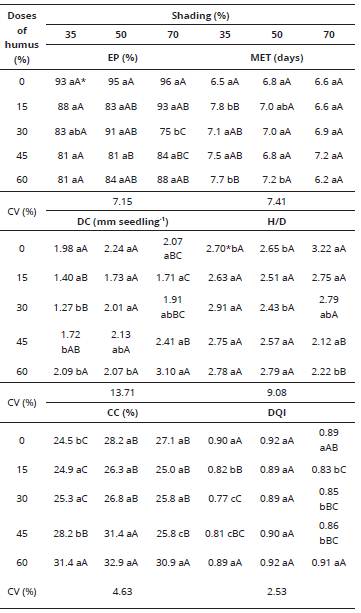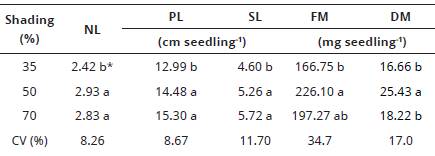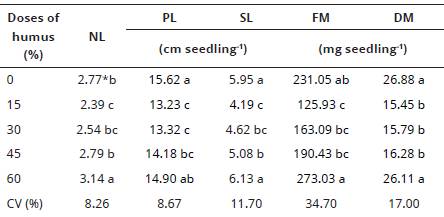Introduction
Lactuca canadensis L. belongs to the family Asteraceae. It is popularly known as wild lettuce, tall lettuce or Florida blue lettuce (Kinnup and Lorenzi, 2014). This species is biennial and produces leaf rosettes in the first year and tall stems in the second year. It reaches maximum heights of 0.5-2.0 m (Michalska, Szneler and Kisiel, 2013). Native to North America, it is one of the most common species of the genus (Lebeda, Dolezalova and Novotna, 2012). Lactuca canadensis L. is an unconventional food plant (UFP) (Kinnup and Lorenzi, 2014) which occurs spontaneously. This species has characteristics of rusticity, which allows its economic production. In addition, Michalska, Szneler and Kisiel (2013) have identified compounds in the roots of L. canadensis that may have medicinal properties.
Although it presents characteristics desirable to production as a vegetable (resistance and adaptation to diverse environments), there is no information regarding the cultivation of Lactuca canadensis L. especially in relation to the production of seedlings. Thus, the study of suitable conditions for the cultivation of this species is essential. Such study aims to obtain an efficient production as already established for other species (Freitas, Silva, Barros, Vaz-de-Melo and Abrahao, 2013; Goes, Dantas, Araujo, Melo and Mendon^a, 2011; Hirata and Hirata, 2015; Neves et al., 2016).
An efficient production of seedlings requires adequate conditions to plants since each species presents different levels of adaptation to production methods. Luminosity and temperature exert a great influence on the response of seedlings to substrates. In tropical climate conditions, high luminosities have been limiting the production of leafy vegetable seedlings such as Rorippa nasturtium-aquaticum (Hirata and Hirata, 2015). In addition, high luminosity with high temperatures can make the production of seedlings unfeasible. In order to minimize the influence of such factors, shading screens have been widely used in the production process.
Another important factor is the substrate. It should have adequate characteristics, such as good water retention, nutrient availability and root aggregation. The objective of this study is to evaluate the production of Lactuca canadensis L. seedlings in a substrate containing different doses of earthworm humus and three levels of shading.
Material and methods
The experiment was carried out from August to September in Cuiaba, Mato Grosso state (15°36’33’’ S, 56°03’55’’ W and altitude of 145 m). Lactuca canadensis L. seeds were obtained from matrices plant, collected at physiological maturity. At this point, they presented a black coloration and panicle dispersion. Subsequently, the seed water content was determined in subsamples of 0.2 g using the oven method at 105 ± 3 °C for 24 h with three replications (Brazil, 2009). The average water content was 10%.
The experiment was completely randomized in a 4 x 5 factorial design (four levels of shading and five doses of humus) with four replications. The levels of light were obtained using black polyethylene screens with 35, 50 and 70% shading, plus a treatment in full sun (without shading). The substrates were composed of commercial vegetable substrate (CS) (Vivatto Slim® plus) and earthworm humus at the ratios 0, 15, 30, 45 and 60% (v:v). The commercial substrate was composed of charcoal mill, pine bark and peat, according to the manufacturer. Subsequently, the substrates were distributed into 128 expanded polystyrene trays (depth: 56 mm, width: 35 mm) with 34.6 cm3 of capacity per cell. Sowing was performed by placing approximately six seeds per cell at a depth of 2 mm. The seeds were covered with a thin layer of expanded vermiculite to avoid direct exposure to the sun, wind and irrigation water. Thinning was carried out at 14 days after sowing. Only the most vigorous seedlings remained in each cell. Irrigation was performed manually using a watering twice a day.
Fourteen useful plants were selected in each plot after discarding the borders. The evaluated characteristics were emergence percentage (EP) by counting the emerged seedlings; mean emergence time (MET) using the equation of Labouriau (1983) by observing the daily number of emerged seedlings, until stabilization; stem diameter (SD) by measuring the stem at ground level with a digital caliper; chlorophyll content (CC) determined in the second younger leaf with a digital chlorophyll meter (chlorofiLOG CFL1030); plant height/stem diameter ratio (H/D); Dickson quality index (DQI) (Dickson, Leaf and Hosner, 1960); number of leaves (NL) by counting the completely expanded leaves; plant length (PL) considering the length from the root end to the leaf end; shoot length (SL) measured from the plant base to the leaf end; fresh (FM) and dry matter (DM) obtained by the difference of plant weight before and after drying in an oven with forced air ventilation for 72 h at 60°C. An analysis of variance was performed and when significant, a Tukey test was carried out (p < 0.05), using the software Sisvar 5.6 (Ferreira, 2011).
Results
For the variables seedling emergence, mean emergence time, stem diameter, chlorophyll content, plant height/stem diameter ratio and Dickson quality index, there was interaction between levels of shading and humus doses.
The emergence percentage of L. canadensis L. seedlings was generally above 80%. However, it did not differ statistically among levels of shading, except for plants sown at 70% shading in the substrate containing 30% humus. In these conditions, there was an emergence of 75% (Table 1). In treatments without shading (full sun), there was no emergence of seedlings.
Table 1 Emergence percentage (EP), mean emergence time (MET), stem diameter (SD), plant height and stem diameter ratio (H/D), chlorophyll content (CC) and Dickson quality index (DQI) of Lactucacanadensis L. grown in different doses of humus (0, 15, 30, 45, 60%) and shading levels (35, 50 and 70%).

*Means followed by the same lowercase letters in lines and uppercase letters in columns do not differ statistically by Tukey test (P < 0.05). CV = Coefficient of Variation.
Regarding humus doses in each environment, the substrates without humus under 50 and 70% shading allowed the highest emergence percentages. For the mean emergence time, observing the levels of shading in each humus doses, in the substrates with 15 and 60% of humus, the 70% of shading allowed the emergence in a shorter time. Other humus doses did not differ. Comparing the doses of humus and the shading levels, the substrate without humus provided the shortest time for emergence of seedlings at 30% of shading. Under 50 and 70% shading, there were no differences in MET among humus doses (Table 1).
In stem diameter, there was an increasing tendency in function of increases in shading levels. This difference becomes more evident as the dose of humus in the substrate increases (Table 1). Evaluating the humus doses, the 60% dose was superior to the others doses for seedlings under 70% shading.
For the relation between plant height and stem diameter, the plants at 35 and 50% shading did not differ among themselves considering the addition of humus to the substrate. However, the highest values occurred in plants sown on substrates with 0, 15 and 30% humus at 70% shading. There was a higher growth in height, but an increase in stem diameter did not follow.
The chlorophyll content was little influenced by shading levels. There was a difference between the substrates without humus: the 35% shading provided a lower chlorophyll content in leaves (Table 1). The increase in humus doses in the substrate caused an increase in the chlorophyll content at all shading levels.
The Dickson quality index increased at 15, 30 and 45% humus doses under 50% shading (Table 1). In the unfolding of humus doses in function of shading levels, plants at 35 and 70% shading and substrates containing 0 and 60% humus were superior to the others. For plants at 50% shading, there was no difference in DQI.
Regarding number of leaves, plant length, shoot length, fresh and dry matter, the interaction between shading levels and humus doses was not significant. Therefore, there was an isolated effect of factors.
Seedlings under 50 and 70% shading presented a higher number of leaves than those under 35% shading. The same tendency was observed for plant length, shoot length and fresh seedlings matter. For dry matter, the of 50% shading allowed the development of plants with a higher mass (Table 2).
Table 2 Number of leaves (NL), plant length (PL), shoot length (SL), fresh (FM) and dry matter (DM) of Lactuca canadensis L. in different shading levels (35, 50 and 70%).

*Means followed by the same letters, in the columns, do not differ statistically by Tukey test (P < 0.05). CV = Coefficient of Variation.
As for humus doses, seedlings produced in substrate with 60% humus had a higher number of leaves. However, seedlings produced in a substrate without and with 60% of humus were superior than other humus doses for the remaining variables (length, height, fresh and dry matter) (Table 3).
Table 3 Number of leaves (NL), plant length (PL), shoot length (SL), fresh (FM) and dry matter (DM) of Lactuca canadensis L. grown in different doses of humus (0, 15, 30, 45, 60%).

*Means followed by the same letters, in the columns, do not differ statistically by Tukey test (P < 0.05). CV = Coefficient of Variation.
Discussion
Development of .Lactuca canadensis L. seedlings under full sun was influenced by high temperatures potentiated by the high luminosity during the experimental period. This condition did not allow the evaluation of seedlings in treatments without shading, since there was no emergence of seedlings in this condition.
This plant originates from cold regions of the North American continent (Lebeda et al., 2012). In these regions, there is a predominance of mild temperatures at the time of seed dispersal. It can determine the absence of germination at high temperatures, as occurred in the full sun treatment.
Callegari, Santos and Scapim (2001) verified that high temperatures (between 30 and 35°C) cause a decrease in seedling emergence of lettuce.
In order to minimize the effects of excess light and high temperatures, shading screens can be used (Hirata and Hirata, 2015; Neves et al., 2016).
For shaded treatments, there was little influence of shading level on seedling emergence. Beltrame, Lopes, Mengarda, Manhone and Freitas (2014) also observed this on the seedling production of Joannesia princeps Vell. In relation to the influence of humus doses in the substrate, the substrate composition caused different responses in the emergence of L. canadensis L. seedlings. Mauri, Lopes, Ferreira, Amaral and Freitas (2010) evaluated broccoli seeds and obtained variations in germination according to different compositions of substrates.
For mean emergence time and stem diameter, as higher was the shading level, greater was the speed of emergence and the stem diameter. This may be related to the maintenance of substrate moisture during the germination/emergence process because of less water loss from the substrate by evaporation. Costa, Rodrigues, Alves, Santos and Vieira (2009) confirmed the effects of shading on the reduction of water evaporation, generating favorable conditions for the development of yellow passion fruit seedlings.
In general, stem diameter has been used as an indicator of the quality standard of seedlings, that is, seedlings with a smaller and very large stem base diameter are considered of inferior quality due to etiolation (Beltrame et al., 2014). Therefore, the development in height should be accompanied by an increase in the stem diameter, avoiding etiolation and seedlings falling.
For seedlings under 35 and 50% shading, the increase in height and stem diameter was proportional at different humus doses. However, for seedlings under 70% shading, the increase in humus dose caused a better developmental balance due to lower H/D values. Harmony in the morphological development of the seedling allows a balanced growth in relation to height and stem diameter, avoiding falling. Souza, Barros, Silveira Santos and Silva (2013) stated that the balance between base diameter and seedling height is important for the estimation of seedling growth after definitive planting in the field.
As for chlorophyll content, the maximum concentrations of chlorophyll occurred at the highest doses of humus. Therefore, there is an effect related to the addition of humus to the substrate. According to Armond et al. (2016) the increase in chlorophyll content may be associated with increasing doses of organic fertilization and greater availability of nutrients. They are constituent elements of the plant chlorophyll molecule.
The Dickson quality index relates morphological parameters, allowing inferences on the development and obtaining of quality seedlings. The highest values occurred in plants under 50% shading. There was no difference between humus doses at this shading level. In all evaluated treatments, the DQI was higher than 0.20, which is the minimum value Hunt (1990) stipulated. However, seedlings with better development and greater morphological balance present a competitive advantage when taken to the field.
For number of leaves, plant length, shoot length, fresh and dry matter, seedlings under the highest shading levels (50 and 70%) generated plants with a greater vigor possibly due to the conservation of moisture in these substrates, as a consequence of less water loss by evaporation. According to Gomes, Francisco, Gemin, Rossa and Westphalen (2017) the number of leaves is an important factor because it indicates the plant’s photosynthetic capacity and, consequently, the capacity to assimilate carbon, increasing vigor and seedling quality.
For humus dose, the substrate without and with 60% of humus were prominent. The substrate with the highest dose presented superior results for number of leaves. However, for the other variables (seedling emergence, mean emergence time, stem diameter, plant height and stem diameter ratio, Dickson quality index, plant length, shoot length, fresh and dry matter) there were no differences. So, the pure commercial substrate can be used considering the benefit/cost ratio.
Conclusions
Shading is essential for the production of Lactuca canadensis L. seedlings since sowing under full sun inhibits the emergence. Among the levels studied, the black polyethylene screen with 50% shading allows the best development of seedlings. The commercial substrate without humus and the 60% humus dose favor the production of seedlings of L. canadensis L. The addition of humus to the substrate at a dose of 60% also causes an increase in the number of leaves and chlorophyll content of plants.














